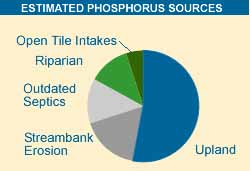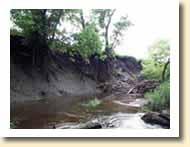The
vast majority of sediment, phosphorus, and nitrate losses from the watershed
take place in the spring months. More than 60 percent of the growing season
load carried by Seven Mile Creek to the Minnesota River occurs in just
three months-April, May and June.
Where is the Sediment Coming From?
Research estimates that close to 50% of the sediment in the watershed
is derived from bank erosion located in the lower portion of the watershed.
Although stream bank erosion is a natural process, changes in watershed
hydrology (more efficient drainage system and changes in vegetation cover
and climate) have likely accelerated the amount of erosion. The other
half is derived from upland areas (31%), erosion prone areas closest to
the drainage ditches (riparian areas 13%), and open tile intakes (7%).

Where are the Nitrates
Coming From?
For its size, Seven Mile Creek Watershed has particularly high nitrate
loads. It had the highest loads overall when compared to nine other watersheds
in the Minnesota River Basin (2000 data). There are many sources of nitrates
in the watershed but the largest source is most likely derived from excess
nitrate leaching through the soil profile and into the network of agricultural
drainage tile systems.
Where is the Bacteria Coming From?
(Fecal coliform)
The presence of Escherichia Coli (a type of fecal bacteria) suggests that
human and/or animal wastes are entering Seven Mile Creek. The concentration
of these bacteria is an indicator of the probability of contamination
of water by microbial pathogens that could pose a threat to public health.
The main sources of fecal bacteria in the watershed can include non-complying
septic systems, and direct runoff from feedlots and manure applied to
fields.
Where is the Phosphorus Coming From?
Over 50 percent of the phosphorus is estimated to come from upland cultivated
lands (53%), streambank erosion (17%), outdated septics (13%), riparian
areas (12%), and open tile intakes (5%).






BNC home | mrbdc home | web site map |